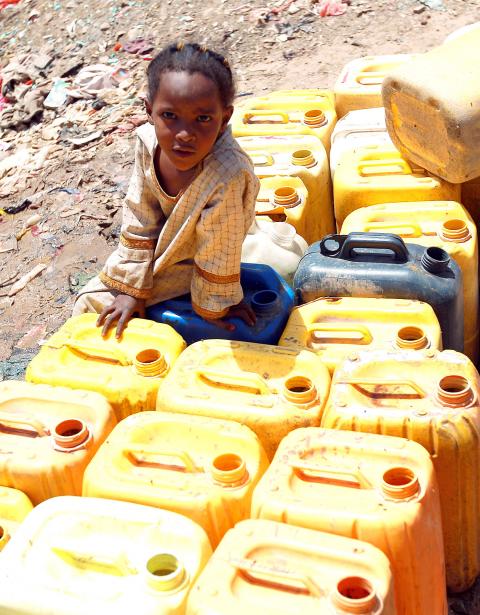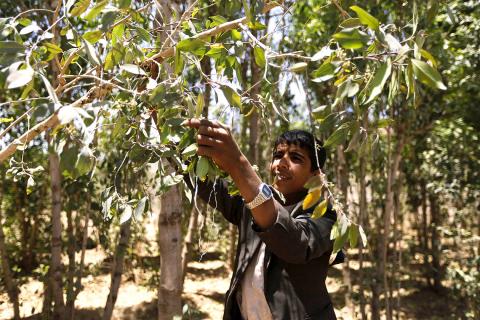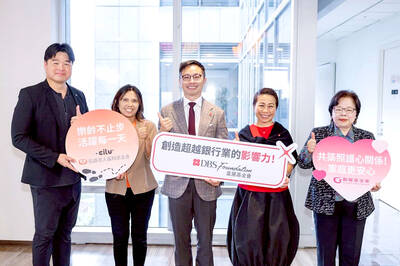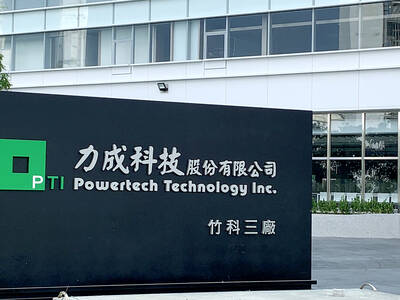Mountainous Yemen is blessed with more water than its Arabian desert neighbors, but the national passion for chewing the stimulant plant qat threatens to exhaust that precious resource.
In the mountains around the Yemeni capital, Sana’a, farmers are drilling so many unlicensed boreholes to irrigate the thirsty crop craved by the city’s residents that the water table is falling by as much as 6m a year. As a result, engineers now have to drill 1,500m in some areas before reaching the aquifer.
Qat is an evergreen shrub native to the Arabian Peninsula and the Horn of Africa, and chewing its leaves and shoots as a stimulant dates back centuries. Yet it is only in the past half century that its consumption has spread from the elite to become a focal point of Yemeni social and business life.

Photo: AFP
For Yemeni men, an afternoon chewing qat while decked out in traditional robes is an opportunity to cement social ties, seal business deals, or debate the issues of the day, and now increasing numbers of women and teenagers are also indulging in the habit.
Sales of qat in Yemen are estimated to run to US$800 million a year, a huge sum in a country ranked by the UN as 160th in the world for human development — the lowest in Asia bar war-torn Afghanistan.
Only 10,000 hectares were given over to cultivation of the crop in the 1970s, but by 2012 that figure had risen to 167,602 hectares, accounting for 12 percent of Yemen’s arable land.

Photo: Reuters
Its attraction to farmers is not difficult to understand. According to the Yemeni of Ministry Agriculture, qat can earn a planter US$12,500 a hectare, three times the revenue of any other crop. It takes five years to get a harvest from a fruit tree, but just a few months for a qat plant, and it can be harvested as many as four times a year.
However, each crop comes at a heavy cost in water usage since the plants are watered heavily for a month before harvesting to ensure that the tender leaves and shoots that users chew are as soft and moist as possible. One day’s supply of qat for a single user requires an estimated 500 liters of water to produce.
In Sana’a Province alone, there are 4,000 wells drilled without authorization to irrigate qat, water expert Omar Madhaji said. Excessive pumping is lowering the level of the water table by 3m to 6m annually, he warned.
Geologist Ismael al-Janad said that the Sana’a Basin aquifer is being drained at an unsustainable rate.
“The only alternative to the depletion of the water table is to take urgent measures to prohibit the use of water pumped from the aquifer for irrigation,” he added.
Yemeni Minister of Water Abdo Razaz Saleh acknowledged that the government had failed to stop unlicensed companies from digging deep wells, adding that 150 such companies operate in Sana’a alone, among 950 nationwide.
The upshot is that in a country that enjoys much higher rainfall that its mainly desert neighbor Saudi Arabia, mains water is heavily rationed, even for those who have it.
In Sana’a, a city of about 3 million people, only 45 percent of households have mains water and the taps are switched on just twice a week, water authority chief Ali al-Sarimi said.
Everyone else relies on privately owned boreholes.
“Most people in this area depend on the well,” resident Bashir Nashwan said as he queued at one Sana’a pumping station. “The water is provided by a generous donor, but it is always crowded and we have to queue for hours.”
Sarifi said just one-third of the 3 billion cubic metes of water that Yemen consumes each year comes from renewable sources. The rest comes from aquifers that have taken millions of years to form and cannot be replaced.

US sports leagues rushed to get in on the multi-billion US dollar bonanza of legalized betting, but the arrest of an National Basketball Association (NBA) coach and player in two sprawling US federal investigations show the potential cost of partnering with the gambling industry. Portland Trail Blazers coach Chauncey Billups, a former Detroit Pistons star and an NBA Hall of Famer, was arrested for his alleged role in rigged illegal poker games that prosecutors say were tied to Mafia crime families. Miami Heat guard Terry Rozier was charged with manipulating his play for the benefit of bettors and former NBA player and

The DBS Foundation yesterday announced the launch of two flagship programs, “Silver Motion” and “Happier Caregiver, Healthier Seniors,” in partnership with CCILU Ltd, Hondao Senior Citizens’ Welfare Foundation and the Garden of Hope Foundation to help Taiwan face the challenges of a rapidly aging population. The foundation said it would invest S$4.91 million (US$3.8 million) over three years to foster inclusion and resilience in an aging society. “Aging may bring challenges, but it also brings opportunities. With many Asian markets rapidly becoming super-aged, the DBS Foundation is working with a regional ecosystem of like-minded partners across the private, public and people sectors

BREAKTHROUGH TECH: Powertech expects its fan-out PLP system to become mainstream, saying it can offer three-times greater production throughput Chip packaging service provider Powertech Technology Inc (力成科技) plans to more than double its capital expenditures next year to more than NT$40 billion (US$1.31 billion) as demand for its new panel-level packaging (PLP) technology, primarily used in chips for artificial intelligence (AI) applications, has greatly exceeded what it can supply. A significant portion of the budget, about US$1 billion, would be earmarked for fan-out PLP technology, Powertech told investors yesterday. Its heavy investment in fan-out PLP technology over the past 10 years is expected to bear fruit in 2027 after the technology enters volume production, it said, adding that the tech would

YEAR-END BOOST: The holiday shopping season in the US and Europe, combined with rising demand for AI applications, is expected to drive exports to a new high, the NDC said Taiwan’s business climate monitor improved last month, transitioning from steady growth for the first time in five months, as robust global demand for artificial intelligence (AI) products and new iPhone shipments boosted exports and corporate sales, the National Development Council (NDC) said yesterday. The council uses a five-color system to measure the nation’s economic state, with “green” indicating steady growth, “red” suggesting a boom and “blue” reflecting a recession. “Yellow-red” and “yellow-blue” suggest a transition to a stronger or weaker condition. The total score of the monitor’s composite index rose to 35 points from a revised 31 in August, ending a four-month